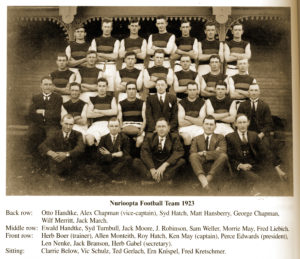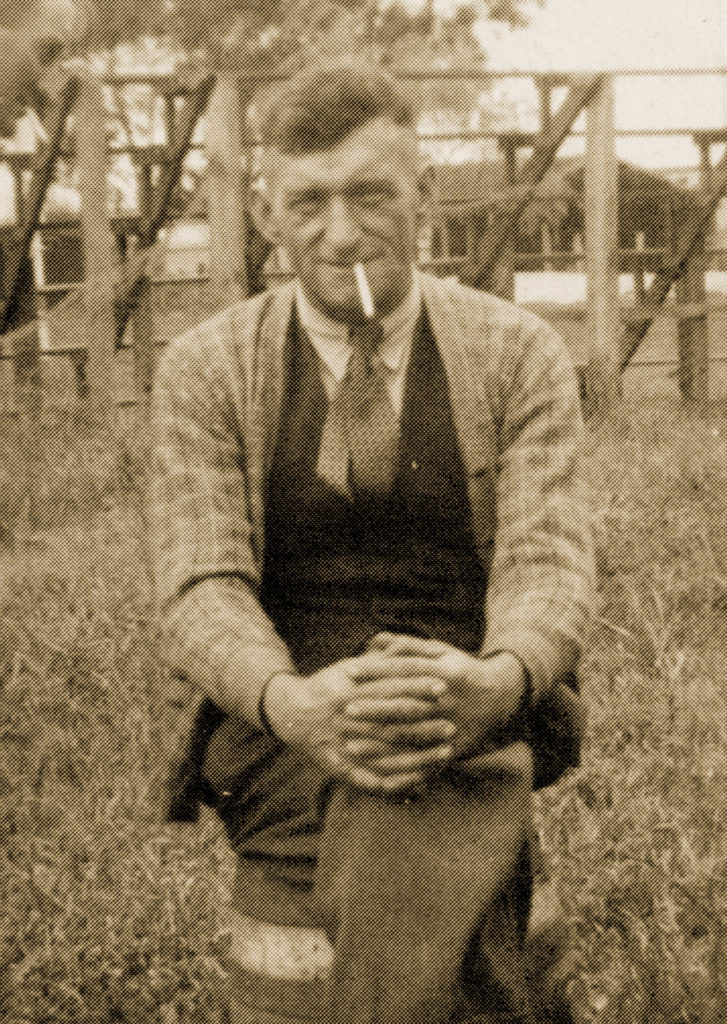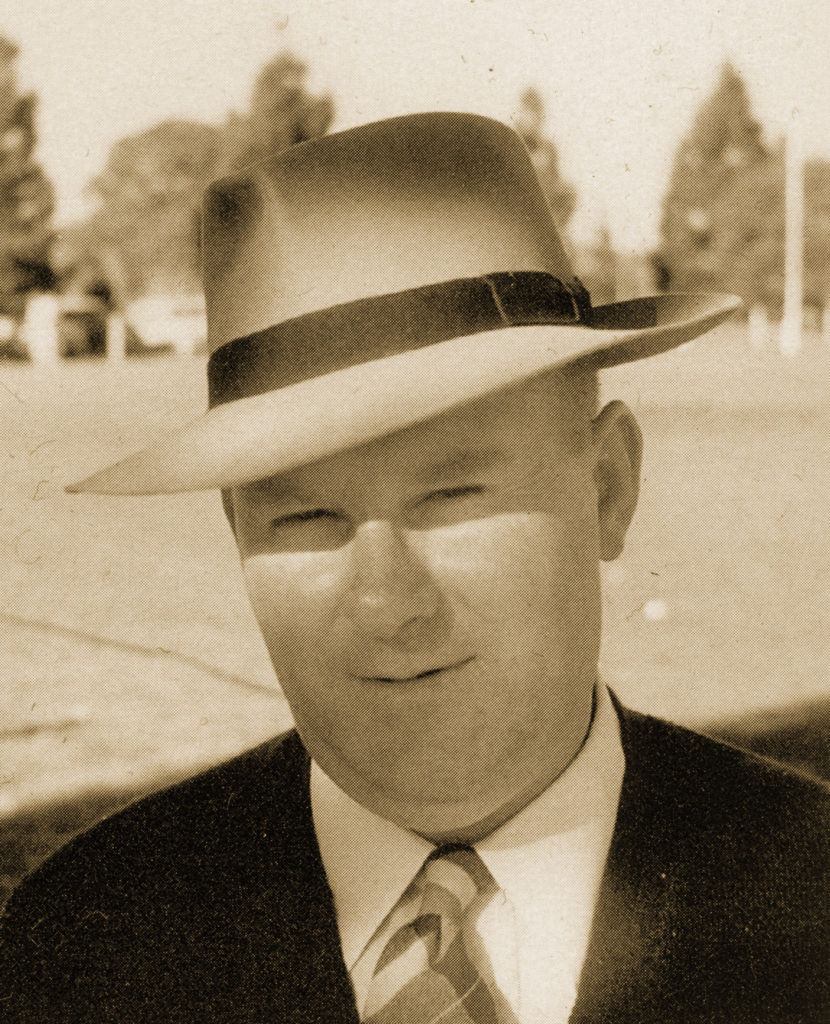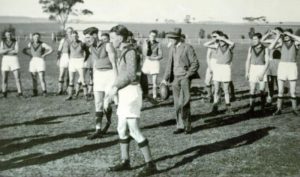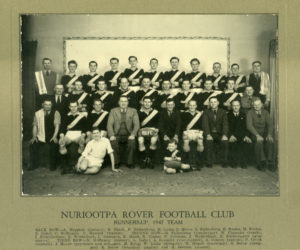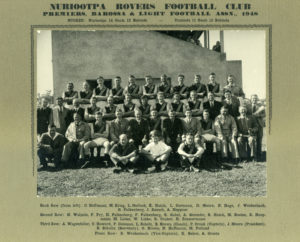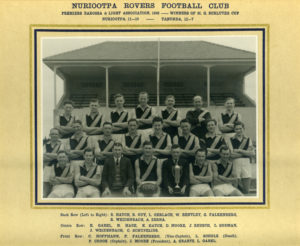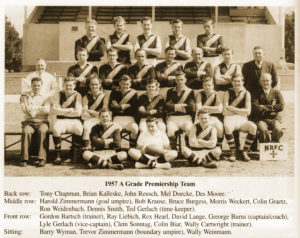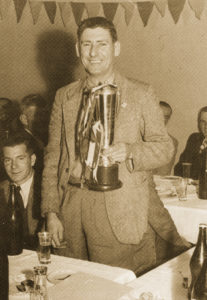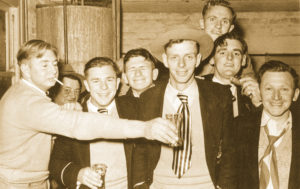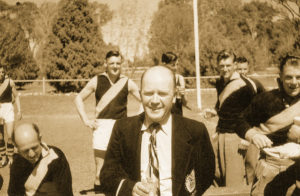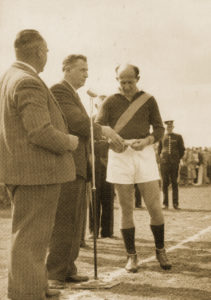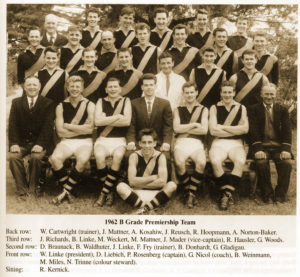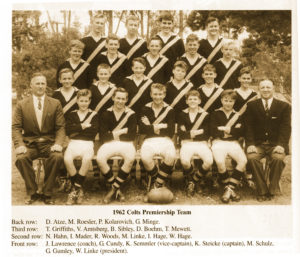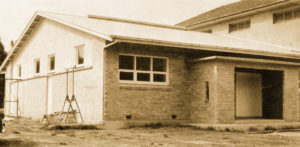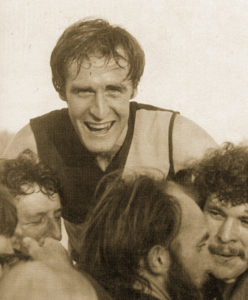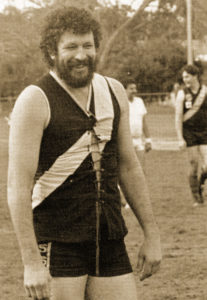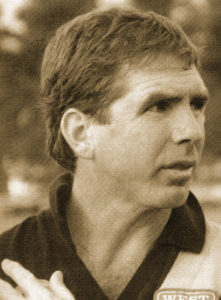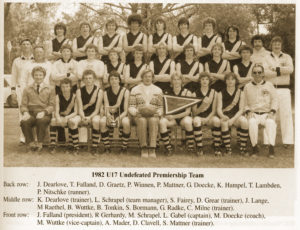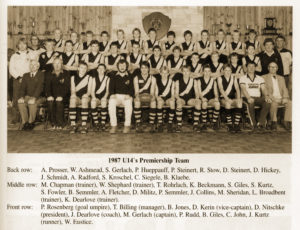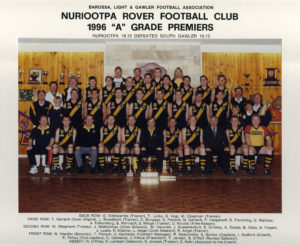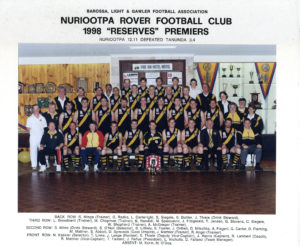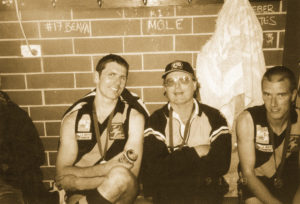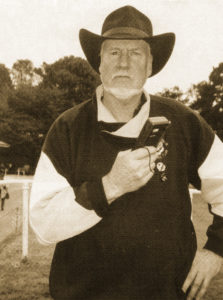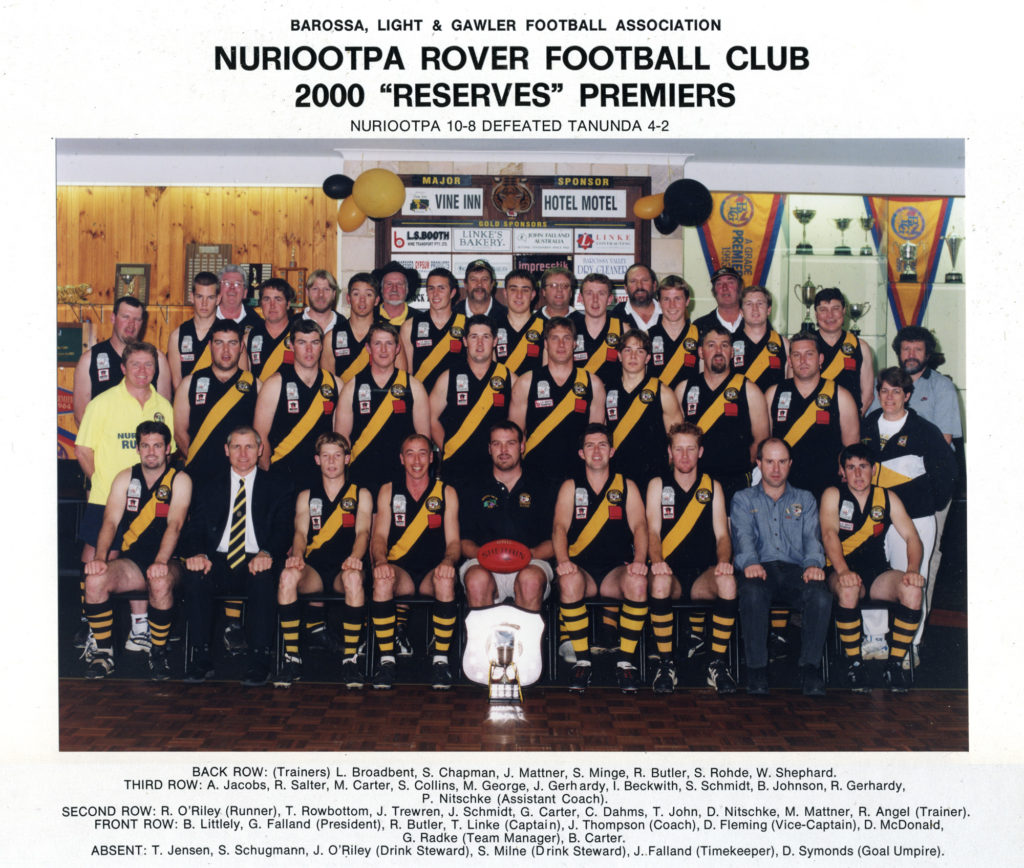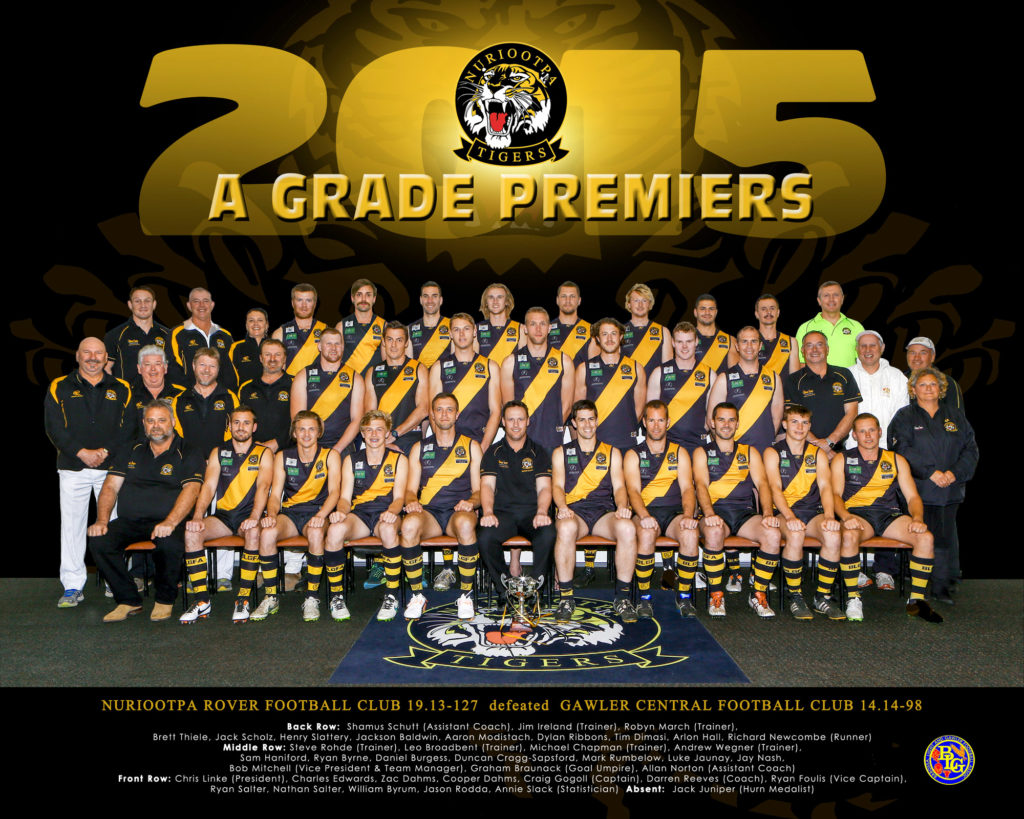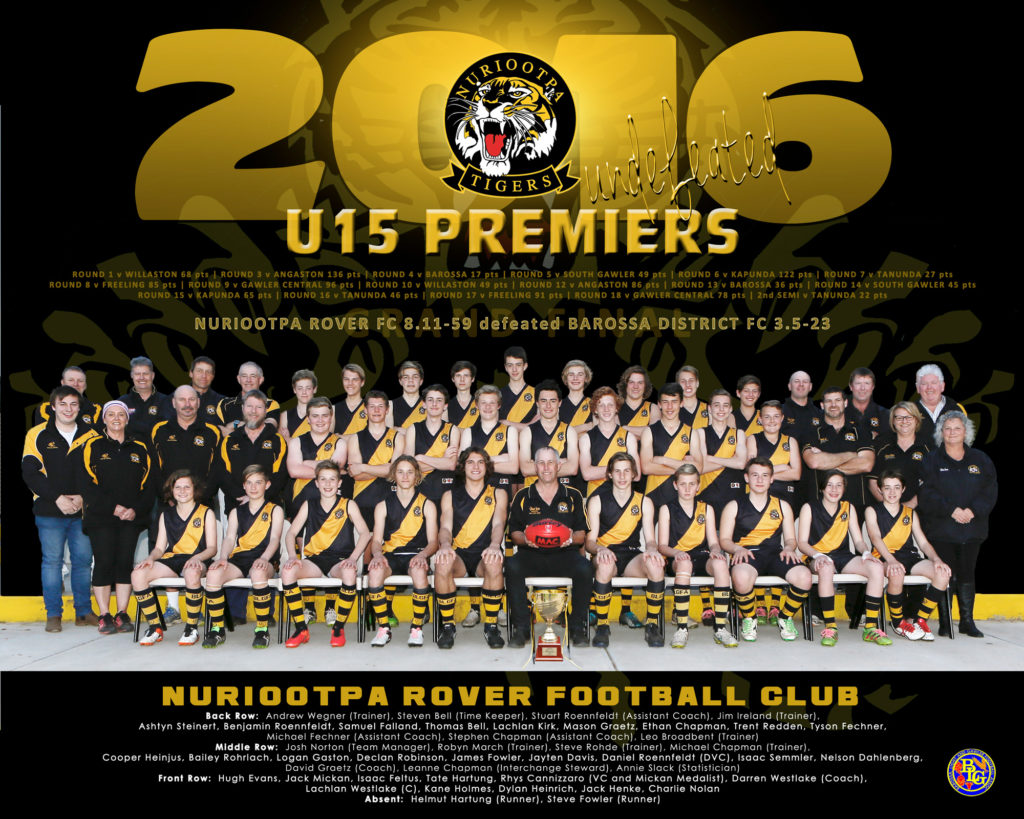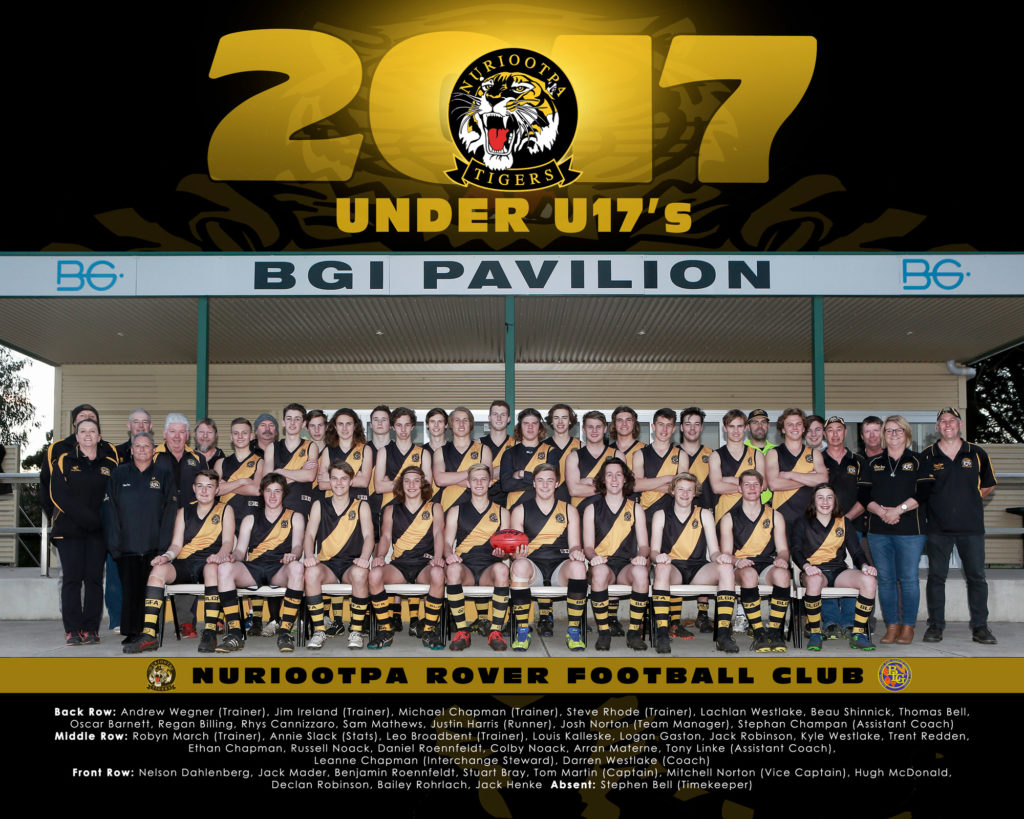HISTORY
100 YEARS OF FRUSTRATION – EXHILARATION
AND PROUD HISTORY
Credit: Peter Rosenberg
Like many country football clubs the actual date when the Nuriootpa football club was first formed of fielded a team is unknown. However records show that a team representing Nuriootpa was playing some matches in the late 1800’s.
When the Barossa and Light Football Association was officially formed on the 18th March 1908 Nuriootpa was one of the 5 foundation clubs that started the association and took part in the first season. The first official colours of the club were blue and gold striped jumpers with black hose.
However history shows that in the first years of the competition the fledging Nuriootpa club struggled. It did not win a game in 1908 and withdrew from the association until the 1915 season and again failed to win a match – then football went into recess for the duration of World War I.
Following the end of the war football started again in 1919 but Nuriootpa did not rejoin the competition until 1920. It then changed the colour of its uniform to chocolate and blue. The change of colours was in honour of one of its champions, Alec Chapman who had served with distinction in the 2/48th battalion during the war. The battalion colours were chocolate and blue.
The 1920’s saw the club gather momentum and on 3 occasions in 4 years played off for the premiership but lost every time. A disappointing and frustrating result for those that took part – the club desperately needed a premiership.
But worse was to follow in the 1930’s. In 1931 the club was reasonably successful and played in the finals but failed to win the premiership. At the end of the season the players went on an end of season trip to Victor Harbor which ended in disaster for the club. It is alleged the players drank all the club funds sending it bankrupt. The Nuriootpa Football Club went in recess and withdrew from the association for the next 2 years and some of its best players went and played for Tanunda. One of those was club captain Perce Mattner who then went on to captain Tanunda.
While in recess social matches were played keeping the game alive in the community – then in 1933 wheels were set in motion to form a new football club and rejoin the Barossa and Light Association. The driving force behind the move was 2 great football pioneers in George Heath and Jack Moore. Rumour has it that George Heath paid off many of the old club’s debts. In 1934 the new club adopted the name the Nuriootpa Rover Football Club and re-entered the association. At the annual general meeting in April 1934 the club started with a balance of $12.
The next 5 years would turn out to be the most disastrous in the club’s history. At the end of the 1934 season the premiership table showed that the Nuriootpa team had only kicked 426 points in its 15 matches and had 1983 points kicked against it. In 5 seasons it could only win one match and that was in 1938.
Worse was to follow the traumatic 1934 season – in 1935 the club set a record which stands to this day in A Grade football – it failed to score against Tanunda who kicked 36-22 to Nuriootpa no score. It was in this match that club legend Harold (Doc) Zimmermann recorded that Nuriootpa finished the match with only 7 players.
In 1936 it did not get much better and on many occasions the team could only field 12-14 players. But off the field it was a very special year for the Nuriootpa community. 1936 was the centenary year of the Commonwealth and as part of the celebrations the community built and opened a new sporting oval. Despite a few local protests the old park was closed and a new football ground was built on Penrice Road on land donated by the town benefactor William Coulthard.
The new park was officially opened during four days of centenary celebration starting on November 1st 1936. Today the Nuriootpa Centennial Park is one of the best of its kind in South Australia. In 1937 as part of a fund raising drive for the new park Don Bradman brought his team to play against a Barossa and Light cricket team at the oval complex.
After 5 years of agony the club again started to generate momentum and enthusiasm with an increasing number of young players. Then after 32 years of trying it eventually happened – in 1940 under Coach Jack Moore it won its first premiership beating Tanunda in the grand final. The whole town went mad – it is hard to envisage the emotion and excitement that emerged on that day and what it did for the community of Nuriootpa. A magnificent celebration was held in the town hall with all players receiving trophies and a night which set the scene for the years to follow.
Then – football was forgotten and the young men who helped win the premiership went to war - again football went into recess and only started again in 1945. 1946 saw another change of colours for the Nuriootpa club – since 1920 the official colours were chocolate and blue but rumour has it that these colour jumpers were no longer manufactured. The club had to come up with new official colours – the officials of that time selected black and gold and so the Nuriootpa Tigers were born.
Soon after the end of the war Roy Brown was appointed the new headmaster at the Nuriootpa primary school. Roy was a former captain of West Torrens and had represented the state. Roy quickly got involved in the community and had all the young men kicking a football. He went on to coach the A Grade to the 1948 premiership. This was followed by another premiership in 1949 under coach Loth Scholz.
The club was on a roll and it continued into the 1950’s when in 10 years it played in 7 grand finals winning the A Grade premiership in 1954 – 1957 and 1958. In the same period it played in 8 B grade grand finals winning 7 premierships.
The 1960’s was another special time for the club – while it played in 5 grand finals and only won 2 A Grade premierships the special historical moment was the opening of the social clubrooms by Roy Brown in April 1962. Back in 1950 a small group of dedicated clubmen including George Heath, Jack Moore, Frank Falkenberg, Ron Weidenbach, Perce Crook and Harold Zimmermann decided the club needed its own clubrooms. From then on each year a small amount of money was put aside in a special building fund. Plans were drawn up but progress was slow in generating the funds needed. In 1959 work on the building started using voluntary labour – this dragged on over the next 2 years – the volunteers were running out of steam so the club borrowed funds from the National Bank to complete the building.
The official opening was on the 29th April and guests at the official opening included League footballers Neil Kerley, John Abley, Don Roach and Trevor Reu as well as representative of the association and kindred clubs. It was a gala occasion to celebrate the opening of the first clubrooms of its type in the association. Today after many additions it provides excellent facilities for club members – a vision that started over 50 years ago.
Success continued in the 1970’s winning A Grade premierships in 1975 and 1976 under Coach Robin Mulholland. Robin a passionate Irishman, whose nickname was naturally ‘Irish” joked that he was the first Irishman to come to the Barossa to teach the Germans how to play football.
For the next 18 years the club went into the doldrums and could only manage to play in 5 first semi finals – 2 second semi finals – 2 preliminary finals and 2 grand finals which were lost. It was a disappointing period for a club who had so much success in the 1940’s, 1950’s, 1960’s and 1970’s.
Something had to be done to turn the club around and get back to being a force in the association. It was left to the club president, John Feltus, vice president Greg Falland and key player Matt Davoren (ex West Adelaide) who were desperate to play in a premiership to search and find the right coach who could bring back success to the floundering club.
After an extensive search and many interviews they came up with Ian Stafford a former junior coach at Port Adelaide and Norwood. When introduced to the club players and members in December 1993 nobody had heard of Ian Stafford but things were about to change. 1994 was a learning curve for ‘Staff’ not being used to players not turning up to training because of vintage commitments and in his first season as coach the team failed to reach the finals – something he was not used to.
The next season he was more familiar with the difference between coaching juniors at league level and country footballers. He demanded discipline and worked on individual skills – the players adjusted to his coaching style and the results followed. Ian Stafford went on to coach 5 A Grade premierships in 6 years – the most successful period in the club’s history. A Grade premierships in 1995, 1996, 1997, 1998 and 2000. The 1998 grand final match at the Willaston oval was one of the best ever grand finals and a great classic match between the 2 great rivals – Tanunda and Nuriootpa. The game was a tight close struggle all day with the lead constantly changing - Tanunda hit the front in the time on – Nuriootpa managed to level the scores – then in the dying seconds John Leake scrambled a point for the Tigers and the siren sounded. A very special win for the Club that will go down as one of the great grand finals in the history books.
With Ian Stafford still in charge he took the team to the 2002 grand final but this time it was Tanunda’s turn and the Tigers lost by 9 points. By now some of the players of the 90’s were at the end of their playing career and there was a change of personnel. At the end of the 2003 season ‘Staff” moved on and was replaced by Martin Leslie ex Port Adelaide and Brisbane Bears as senior coach. Martin a popular figure in the club got the team into the 1st semi final in 2005 which the team lost to Angaston.
In 2006 Scott Lee took over as senior coach – Scott ex Central Districts and Adelaide Crows had previous coaching experience at Central Districts before joining the Nuriootpa Tigers. Scott retained his position in 2008 our centenary year and put in a lot of work developing a young squad but wins did not come easy in the very strong Barossa, Light and Gawler Football Association.
2009 / 2010 saw the return of one of Nuriootpa's favourite, respected & most successful Coach's in the clubs long and rich history of Ian Stafford, but this tenure being less successful than the previous.
In 2011, 2012 & 2013 the reins were handed to a current player & young aspiring coach Natt Salter as a playing coach, originally from Blanchtown. The Salter family having a history with the Nuri footy Club with father Greg, brother Ryan and Natt all committed to playing for Nuri over the years. Natt's playing career having been at Blanchtown, Port Adelaide Magpies, Darwin and of course Nuriootpa Tigers. Natt's attributes were his passion for the Tigers, game strategies with a focus on commiting to develop young up and coming players to be successful footballers and to learn the game. Nathan chose to relinquish the senior coaching position at the end of the 2013 season to concentrate on his own playing career at the Tigers.
2014 saw a change of direction by the committee by reverting back to a non playing coach and appointing Darren Reeves to the Senior Coaching position.
Since 1908 the club has had a roller coaster ride but continues to survive. During the past 100 years there has been turmoil, bankruptcy, devastating losses, dedication, emotional wins and realistic success.
During the period many famous names have worn the club jumper – many players have gone on to play league football – probably the three best known would be Ray Linke (South Adelaide and the State), Terry Moore (Central Districts/ State/Hawthorn and North Melbourne) and currently Jay Nash (Central Districts and Essendon). At the same time the club has been fortunate in having some very famous ex league footballers as a senior coach including John Girardi (Woodville), Don Thompson (Port Adelaide), Barry Barbary (North Adelaide/Woodville) and Robin Mulholland (Central Districts) – all 4 having represented South Australia.
While the above has covered mainly the history of our A Grade team and its coaches we should not forget our other teams that have represented the club in competition In the early years the clubs only had one team – then a B Grade team started on a regular basis in the 1940’s – a colts team in 1959 then this was changed to an U 15’s and U17’s in 1970.
The Nuriootpa Rover Football Club is a proud club – proud of its heritage and proud of its contribution to the Nuriootpa community and the Barossa, Light and Gawler Football Association. It will continue to build and strive for success and provide facilities for the young people of the community to take part in our great game.




